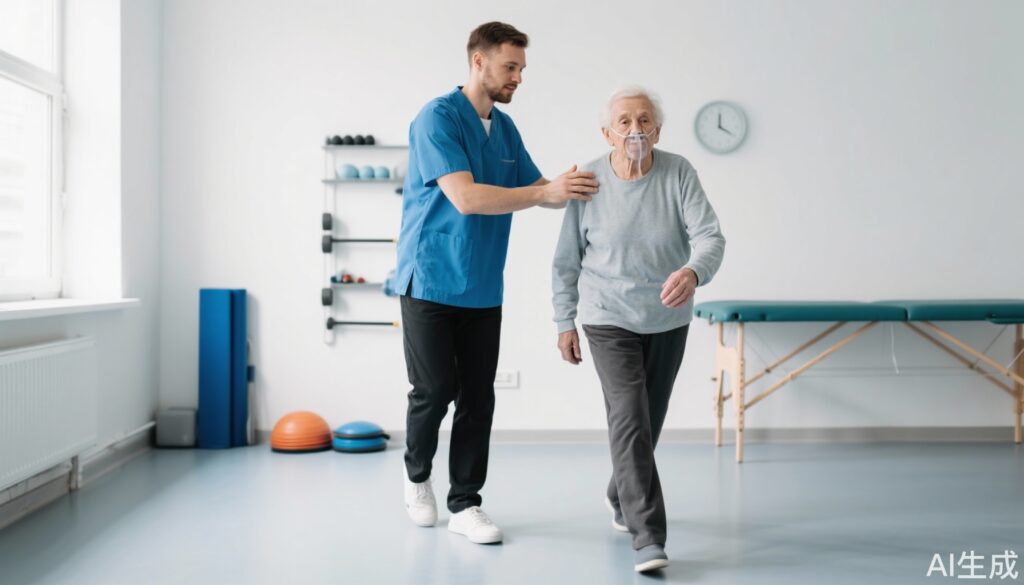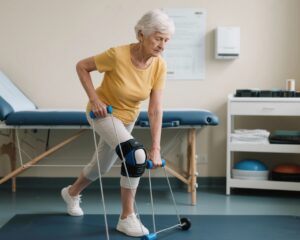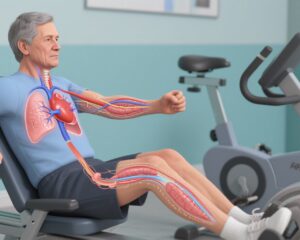Highlight
This randomized clinical trial compared traditional gym-equipment pulmonary rehabilitation (PR-gym) versus a minimal equipment model (PR-min) in patients with chronic respiratory disease. PR-min was found to be noninferior in improving exercise capacity, dyspnea, and health-related quality of life, with no increase in adverse events or costs. This supports broader accessibility to PR using minimal, easily available equipment.
Study Background and Disease Burden
Chronic respiratory diseases, such as chronic obstructive pulmonary disease (COPD) and interstitial lung diseases, impose a significant global health burden characterized by reduced exercise tolerance, persistent dyspnea, and diminished quality of life. Pulmonary rehabilitation (PR) is an evidence-based non-pharmacologic intervention that improves these outcomes by incorporating exercise training, education, and behavioral changes. However, healthcare systems worldwide face challenges due to insufficient PR capacity relative to patient demand.
Conventionally, PR has utilized specialized, gym-based equipment such as treadmills and weight machines, requiring specialized facilities and trained personnel. This specialized equipment limits the availability of PR programs, especially in resource-limited or geographically remote settings.
The question arises whether exercise training using minimal, low-cost equipment can achieve comparable patient benefits, potentially expanding access to effective PR.
Study Design
This study was a parallel-group, randomized, noninferiority clinical trial conducted at the Regional Pulmonary Rehabilitation Unit in northwest London, UK. Eligible participants were adults with chronic respiratory disease referred for outpatient PR. Recruitment occurred between October 15, 2018, and December 21, 2021, with follow-up completed by December 14, 2022.
Participants (N=436; median age 71.7 years, 54.8% male) were randomized 1:1 via an independent web-based system using minimization to two intervention arms: PR using minimal equipment (PR-min) or PR using specialist gym equipment (PR-gym). Both interventions involved two in-person, supervised outpatient sessions per week for 8 weeks.
The PR-min program used minimal exercise modalities, including walking circuits and bodyweight exercises. In contrast, PR-gym employed conventional specialized equipment, such as treadmills and resistance machines.
The primary endpoint was change in incremental shuttle walk (ISW) distance at 8 weeks, with a predefined noninferiority margin of -24 meters. Secondary outcomes included dyspnea severity, health-related quality of life, intervention costs, and adverse event rates.
Key Findings
Out of 436 enrolled participants, 218 were assigned to PR-min and 218 to PR-gym. At 8 weeks, significant improvements in ISW distance were observed in both groups: PR-min (n=136 analyzed) and PR-gym (n=130 analyzed). The between-group difference in ISW distance change was minimal (mean difference 1.7 m; one-sided 97.5% confidence interval lower bound, -16.8), well within the noninferiority margin of -24 m. Intention-to-treat and multiple sensitivity analyses confirmed that PR-min is noninferior to PR-gym in improving exercise capacity.
Secondary outcomes also favored PR-min’s equivalence with PR-gym. Dyspnea scores and health-related quality of life showed similar improvements across groups. Importantly, no excess adverse events, such as exercise-related injuries or hospital admissions, were reported in PR-min compared to PR-gym. Economic analyses revealed no additional cost burden associated with the minimal equipment program.
Overall, minimal equipment PR appears to deliver comparable clinical benefits to the standard gym-based model without compromising patient safety or increasing costs.
Expert Commentary
This landmark trial addresses a critical service delivery challenge in pulmonary rehabilitation by validating a pragmatic, accessible approach that does not rely on expensive or complex gym equipment. The methodology adhered to rigorous randomization, blinding of assessors and statisticians, and appropriate noninferiority margin setting, supporting the robustness of the findings.
From a mechanistic perspective, exercise tolerance improvements in chronic respiratory disease are driven primarily by peripheral muscle conditioning and cardiovascular adaptation rather than the type of equipment used. Minimal equipment programs emphasizing functional and endurance training can adequately stimulate these physiological adaptations.
Limitations include the single-center setting and follow-up restricted to 8 weeks, leaving open questions about long-term adherence and outcomes. However, the trial findings are broadly consistent with previous smaller studies and expert consensus advocating for flexible PR delivery models.
Current clinical guidelines and respiratory societies should consider recommending minimal equipment PR as an alternative where traditional gym-based PR is unavailable or impractical, facilitating broader patient access.
Conclusion
This comprehensive randomized clinical trial demonstrates that pulmonary rehabilitation programs using minimal exercise equipment are noninferior to those using specialized gym equipment in improving exercise capacity, dyspnea, and quality of life for patients with chronic respiratory disease. This finding has critical implications for expanding the availability and accessibility of PR by enabling implementation in diverse healthcare settings without resource-intensive infrastructure.
Healthcare providers and policymakers should consider integrating minimal equipment PR modalities into routine clinical pathways to mitigate current supply-demand gaps and address inequalities in rehabilitative care. Future research should explore long-term outcomes, adherence, and healthcare utilization associated with these innovative PR delivery models.
References
1. Nolan CM, Glen C, Walsh JA, Patel S, Barker RE, Polgar O, Spain N, Littlemore H, Jung P, Edwards GD, et al. Minimal vs Specialized Exercise Equipment for Pulmonary Rehabilitation: A Randomized Clinical Trial. JAMA Netw Open. 2025;8(8):e2526616. doi:10.1001/jamanetworkopen.2025.26616.
2. Spruit MA, Singh SJ, Garvey C, et al. An official American Thoracic Society/European Respiratory Society statement: key concepts and advances in pulmonary rehabilitation. Am J Respir Crit Care Med. 2013;188(8):e13-e64.
3. McCarthy B, Casey D, Devane D, Murphy K, Murphy E, Lacasse Y. Pulmonary rehabilitation for chronic obstructive pulmonary disease. Cochrane Database Syst Rev. 2015 Feb 23;(2):CD003793.



